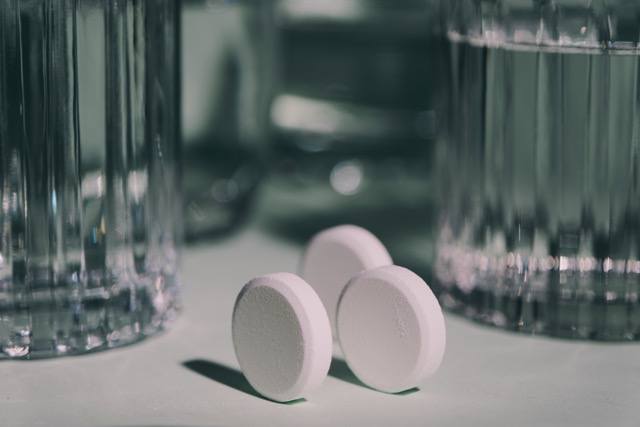Can Spermidine Prevent Aging?
According to research, spermidine can slow down the aging process and promote healthy longevity

Jake Thacker
Some research suggests that spermidine may slow down the aging process and promote healthy longevity. This promising molecule is intended to help delay aging, although it is likely to only have an effect on a small part of the process, such as autophagy.
What is Spermidine?
Spermidine is a polyamine, meaning it has two or more primary amino groups. It occurs naturally, is widely distributed in ribosomes and living tissues, and plays a crucial role in cell function and survival.
Spermidine was first discovered in 1678 by Dutch scientist Anton Van Leeuwenhoek in a sample of human semen. A short time later, spermidine was also discovered in human sperm. In the body, spermidine is formed from its precursor putrescine, which in turn is the precursor of another polyamine called spermine, which is also important for cell functions.
Spermidine and putrescine are known to stimulate autophagy. This is a system that breaks down waste materials in the cells and recycles cell components. It is an important mechanism for quality control of mitochondria, the power plants of our cells. With the help of autophagy, damaged or defective mitochondria can be broken down and disposed of [1].
Polyamines can bind to many different types of molecules, making them very useful. They support processes such as cell growth, DNA stability, cell proliferation, and apoptosis [2]. It also appears that polyamines function similarly to growth factors during cell division. For this reason, putrescine and spermidine are important for the growth and function of healthy tissue.
Which foods are rich in Spermidine?
There are many dietary sources of spermidine, including grapefruit, soy products, legumes, corn, whole grains, chickpeas, green peppers, broccoli, oranges, green tea, rice bran, and fresh green pepper. It's also found in shitake mushrooms, amaranth, wheat germ, cauliflower, broccoli, and a range of aged cheeses.

It's worth noting that much of the Mediterranean diet includes spermidine-rich foods. This could at least explain the phenomenon of “blue zones” and why people often live longer there than elsewhere.
If you do not get enough from your diet, spermidine can also be taken in the form of dietary supplements. The synthetic spermidine used in the preparations is identical to the naturally occurring molecule.
Spermidine and autophagy
Spermidine plays an important role in regulating various biological processes, including intracellular pH and maintaining cell membrane potential. It also plays a central role in a number of important biological processes, including aspartate receptors, cGMP/PKG signaling, nitric oxide synthase, and cerebral cortex synaptosome activity.
Spermidine is of interest to scientists in the context of aging as it is an important morphogenetic determinant of the lifespan of cells and living tissue [3]. The ability of spermidine to trigger autophagy is thought to be the main mechanism by which it appears to slow down the aging process and promote longevity [4]. It has been shown to trigger autophagy in liver cells of mice, worms, yeasts, and flies [5]. An impaired autophagy mechanism and spermidine deficiency are closely linked to a shortened lifespan, chronic stress and acute inflammation.
Anti-inflammatory properties of Spermidine
Although spermidine appears to promote longevity primarily via autophagy, there is also evidence that it supports health and longevity in other ways. Some studies suggest that it has anti-inflammatory properties [6-7] and is involved in lipid metabolism, cell growth and proliferation [8-9] as well as programmed cell death known as apoptosis [10].
It is generally accepted that although inflammation plays a helpful role in wound healing and fighting off invading pathogens, the prolonged inflammation associated with aging, often referred to as inflammaging, is harmful. Chronic inflammation prevents healthy tissue from regenerating, leads to immune cell dysfunction and can even accelerate the aging of healthy cells. Spermidine appears to reduce this chronic inflammation and may slow the aging of cells and tissues.
Spermidine may delay aging
As far as longevity is concerned, spermidine administration has been shown in a number of animal studies to increase life expectancy and prevent liver fibrosis and hepatocellular carcinoma [11-12]. This also appears to be the case with a polyamine-rich diet [13]. There is also some evidence that it improves stress resistance and that the age-related decline in spermidine supports the onset of age-related diseases [14-15].
Lipid metabolism is known to be an important regulator of the lifespan, which is why a lipid metabolism disorder can have serious effects on health and lifespan. The role that spermidine plays in the process of adipogenesis, the formation of adipocytes (fat cells) from stem cells, and its ability to alter lipid profiles could point to another way spermidine affects the lifespan.
A study showed that administration of a-difluoromethylornithine (DFMO), an inhibitor of polyamine synthesis, can completely stop adipogenesis [17]. This complete interruption of lipid metabolism could be reversed by administration of spermidine, although DFMO was still present. The researchers observed that spermidine also restored the expression of transcription factors needed to differentiate preadipocytes, as well as factors associated with late adipocyte markers.
When taken together, the combination of effective autophagy, reduction of inflammation, lower levels of oxidative stress in the cell, improved cell growth, and improved fat metabolism may potentially support healthy longevity.
Side effects of Spermidine
There are no known adverse effects of spermidine supplementation. A number of studies have been done with spermidine and the results suggest that it is safe and well tolerated.
As with any dietary supplement, spermidine use should be stopped immediately and a doctor should be consulted if side effects occur.
Disclaimer
This article is a very brief summary and is based on the interpretation of research data, which is naturally speculative. This article is not intended as a comprehensive guide and is not a substitute for consulting with your doctor about which supplements are or are not right for you.
*The original article was published on Lifespan.io and republished here with their consent.
References
- Goldman, S.J., Taylor, R., Zhang, Y., & Jin, S. (2010). Autophagy and the Degradation of Mitochondria. mitochondrion, 10 (4), 309-315.
- Minois, N., Carmona-Gutierrez, D., & Madeo, F. (2011). Polyamines in aging and disease. Aging (Albany NY), 3 (8), 716-732.
- Deeb, F., van der Weele, C.M., & Wolniak, S.M. (2010). Spermidine is a morphogenetic determinant for cell fate specification in the male gametophyte of the water fern Marsilea vestita. The Plant Cell, 22 (11), 3678-3691.
- Eisenberg, T., Knauer, H., Schauer, A., Büttner, S., Ruckenstuhl, C., Carmona-Gutierrez, D.,... & Fussi, H. (2009). Induction of autophagy by spermidine promotes longevity. Nature cell biology, 11 (11), 1305-1314.
- Eisenberg, T., Knauer, H., Schauer, A., Büttner, S., Ruckenstuhl, C., Carmona-Gutierrez, D.,... & Fussi, H. (2009). Induction of autophagy by spermidine promotes longevity. Nature cell biology, 11 (11), 1305-1314.
- Bjelakovic, G., Stojanovic, I., Stoimenov, T.J., Pavlovic, D., Kocic, G., Rossi, S.,... & Bjelakovic, L.J. (2010). Metabolic correlations of glucocorticoids and polyamines in inflammation and apoptosis. amino acids, 39 (1), 29-43.
- Choi, Y.H., & Park, H.Y. (2012). Anti-inflammatory effects of spermidine in lipopolysaccharide-stimulated BV2 microglial cells.Journal of Biomedical Science, 19 (1), 31.
- Landau, G., Ran, A., Bercovich, Z., Feldmesser, E., Horn-Saban, S., Korkotian, E.,... & Kahana, C. (2012). Expression profiling and biochemical analysis suggest stress response as a potential mechanism inhibiting proliferation of polyamine-depleted cells.Journal of Biological Chemistry, 287 (43), 35825-35837.
- Landau, G., Bercovich, Z., Park, M.H., & Kahana, C. (2010). The role of polyamines in supporting growth of mammalian cells is mediated through their requirement for translation initiation and elongation. Journal of Biological Chemistry, 285 (17), 12474-12481.
- Minois, N., Carmona-Gutierrez, D., & Madeo, F. (2011). Polyamines in aging and disease. Aging (Albany NY), 3 (8), 716-732.
- Yue, F., Li, W., Zou, J., Jiang, X, Xu, G., Huang, H., & Liu, L. (2017). Spermidine prolongs lifespan and prevents liver fibrosis and hepatocellular carcinoma by activating MAP1S-mediated autophagy. Cancer Research, Canres-3462.
- Eisenberg, T., Abdellatif, M., Schröder, S., Primessnig, U., Stekovic, S., Pendl, T.,... & Tong, M. (2016). Cardioprotection and lifespan extension by the natural polyamine spermidine. Nature medicine.
- Soda, K., Dobashi, Y., Kano, Y., Tsujinaka, S., & Konishi, F. (2009). Polyamine-rich food decreases age-associated pathology and mortality in aged mice. Experimental Gerontology, 44 (11), 727-732.
- Minois, N., Carmona-Gutierrez, D., Bauer, M.A., Rockenfeller, P., Eisenberg, T., Brandhorst, S.,... & Madeo, F. (2012). Spermidine promotes stress resistance in Drosophila melanogaster through autophagy-dependent and independent pathways.Cell Death & Disease, 3 (10), e401.
- Landau, G., Ran, A., Bercovich, Z., Feldmesser, E., Horn-Saban, S., Korkotian, E.,... & Kahana, C. (2012). Expression profiling and biochemical analysis suggest stress response as a potential mechanism inhibiting proliferation of polyamine-depleted cells. Journal of Biological Chemistry, 287 (43), 35825-35837.
- Hyvönen, M.T., Koponen, T., Weisell, J., Pietilä, M., Khomutov, A.R., Vepsäläinen, J.,... & Keinänen, T.A. (2013). Spermidine promotes adipogenesis of 3T3-L1 cells by preventing interaction of ANP32 with HuR and PP2A. Biochemical Journal, 453 (3), 467-474.
Publiziert
22.7.2024
Kategorie
Lifestyle

Experte
Scientific Terms
Autophagy
From ancient Greek αφααγоs autóphagos 'eating oneself. '
A normal and orderly process of breaking down and recycling damaged cell components.
Mitochondrion
Mitochondria are often referred to as the cell's powerhouse and break down nutrients to generate energy in a process called cellular respiration. They contain their own circular genome.
DNA
Abbreviation for deoxyribonucleic acid, the molecule that encodes the information that a cell needs to function or a virus needs to replicate. Forms a double helix that resembles a twisted ladder, similar to a zipper. The bases, abbreviated as A, C, T, and G, are on either side of the ladder or strand that run in opposite directions. The bases exert an attraction on each other so that A sticks to T and C to G. The sequence of these letters is known as the genetic code.
Apoptosis
From Greek. apoptōsis = the fall off, e.g. of a leaf
Apoptosis is a strictly regulated physiological process in the form of “cell suicide”, which plays an important role in the development, maintenance and aging of multicellular organisms and in which individual cells are eliminated in a planned manner.
Some research suggests that spermidine may slow down the aging process and promote healthy longevity. This promising molecule is intended to help delay aging, although it is likely to only have an effect on a small part of the process, such as autophagy.
What is Spermidine?
Spermidine is a polyamine, meaning it has two or more primary amino groups. It occurs naturally, is widely distributed in ribosomes and living tissues, and plays a crucial role in cell function and survival.
Spermidine was first discovered in 1678 by Dutch scientist Anton Van Leeuwenhoek in a sample of human semen. A short time later, spermidine was also discovered in human sperm. In the body, spermidine is formed from its precursor putrescine, which in turn is the precursor of another polyamine called spermine, which is also important for cell functions.
Spermidine and putrescine are known to stimulate autophagy. This is a system that breaks down waste materials in the cells and recycles cell components. It is an important mechanism for quality control of mitochondria, the power plants of our cells. With the help of autophagy, damaged or defective mitochondria can be broken down and disposed of [1].
Polyamines can bind to many different types of molecules, making them very useful. They support processes such as cell growth, DNA stability, cell proliferation, and apoptosis [2]. It also appears that polyamines function similarly to growth factors during cell division. For this reason, putrescine and spermidine are important for the growth and function of healthy tissue.
Which foods are rich in Spermidine?
There are many dietary sources of spermidine, including grapefruit, soy products, legumes, corn, whole grains, chickpeas, green peppers, broccoli, oranges, green tea, rice bran, and fresh green pepper. It's also found in shitake mushrooms, amaranth, wheat germ, cauliflower, broccoli, and a range of aged cheeses.

It's worth noting that much of the Mediterranean diet includes spermidine-rich foods. This could at least explain the phenomenon of “blue zones” and why people often live longer there than elsewhere.
If you do not get enough from your diet, spermidine can also be taken in the form of dietary supplements. The synthetic spermidine used in the preparations is identical to the naturally occurring molecule.
Spermidine and autophagy
Spermidine plays an important role in regulating various biological processes, including intracellular pH and maintaining cell membrane potential. It also plays a central role in a number of important biological processes, including aspartate receptors, cGMP/PKG signaling, nitric oxide synthase, and cerebral cortex synaptosome activity.
Spermidine is of interest to scientists in the context of aging as it is an important morphogenetic determinant of the lifespan of cells and living tissue [3]. The ability of spermidine to trigger autophagy is thought to be the main mechanism by which it appears to slow down the aging process and promote longevity [4]. It has been shown to trigger autophagy in liver cells of mice, worms, yeasts, and flies [5]. An impaired autophagy mechanism and spermidine deficiency are closely linked to a shortened lifespan, chronic stress and acute inflammation.
Anti-inflammatory properties of Spermidine
Although spermidine appears to promote longevity primarily via autophagy, there is also evidence that it supports health and longevity in other ways. Some studies suggest that it has anti-inflammatory properties [6-7] and is involved in lipid metabolism, cell growth and proliferation [8-9] as well as programmed cell death known as apoptosis [10].
It is generally accepted that although inflammation plays a helpful role in wound healing and fighting off invading pathogens, the prolonged inflammation associated with aging, often referred to as inflammaging, is harmful. Chronic inflammation prevents healthy tissue from regenerating, leads to immune cell dysfunction and can even accelerate the aging of healthy cells. Spermidine appears to reduce this chronic inflammation and may slow the aging of cells and tissues.
Spermidine may delay aging
As far as longevity is concerned, spermidine administration has been shown in a number of animal studies to increase life expectancy and prevent liver fibrosis and hepatocellular carcinoma [11-12]. This also appears to be the case with a polyamine-rich diet [13]. There is also some evidence that it improves stress resistance and that the age-related decline in spermidine supports the onset of age-related diseases [14-15].
Lipid metabolism is known to be an important regulator of the lifespan, which is why a lipid metabolism disorder can have serious effects on health and lifespan. The role that spermidine plays in the process of adipogenesis, the formation of adipocytes (fat cells) from stem cells, and its ability to alter lipid profiles could point to another way spermidine affects the lifespan.
A study showed that administration of a-difluoromethylornithine (DFMO), an inhibitor of polyamine synthesis, can completely stop adipogenesis [17]. This complete interruption of lipid metabolism could be reversed by administration of spermidine, although DFMO was still present. The researchers observed that spermidine also restored the expression of transcription factors needed to differentiate preadipocytes, as well as factors associated with late adipocyte markers.
When taken together, the combination of effective autophagy, reduction of inflammation, lower levels of oxidative stress in the cell, improved cell growth, and improved fat metabolism may potentially support healthy longevity.
Side effects of Spermidine
There are no known adverse effects of spermidine supplementation. A number of studies have been done with spermidine and the results suggest that it is safe and well tolerated.
As with any dietary supplement, spermidine use should be stopped immediately and a doctor should be consulted if side effects occur.
Disclaimer
This article is a very brief summary and is based on the interpretation of research data, which is naturally speculative. This article is not intended as a comprehensive guide and is not a substitute for consulting with your doctor about which supplements are or are not right for you.
*The original article was published on Lifespan.io and republished here with their consent.
Referenzen
- Goldman, S.J., Taylor, R., Zhang, Y., & Jin, S. (2010). Autophagy and the Degradation of Mitochondria. mitochondrion, 10 (4), 309-315.
- Minois, N., Carmona-Gutierrez, D., & Madeo, F. (2011). Polyamines in aging and disease. Aging (Albany NY), 3 (8), 716-732.
- Deeb, F., van der Weele, C.M., & Wolniak, S.M. (2010). Spermidine is a morphogenetic determinant for cell fate specification in the male gametophyte of the water fern Marsilea vestita. The Plant Cell, 22 (11), 3678-3691.
- Eisenberg, T., Knauer, H., Schauer, A., Büttner, S., Ruckenstuhl, C., Carmona-Gutierrez, D.,... & Fussi, H. (2009). Induction of autophagy by spermidine promotes longevity. Nature cell biology, 11 (11), 1305-1314.
- Eisenberg, T., Knauer, H., Schauer, A., Büttner, S., Ruckenstuhl, C., Carmona-Gutierrez, D.,... & Fussi, H. (2009). Induction of autophagy by spermidine promotes longevity. Nature cell biology, 11 (11), 1305-1314.
- Bjelakovic, G., Stojanovic, I., Stoimenov, T.J., Pavlovic, D., Kocic, G., Rossi, S.,... & Bjelakovic, L.J. (2010). Metabolic correlations of glucocorticoids and polyamines in inflammation and apoptosis. amino acids, 39 (1), 29-43.
- Choi, Y.H., & Park, H.Y. (2012). Anti-inflammatory effects of spermidine in lipopolysaccharide-stimulated BV2 microglial cells.Journal of Biomedical Science, 19 (1), 31.
- Landau, G., Ran, A., Bercovich, Z., Feldmesser, E., Horn-Saban, S., Korkotian, E.,... & Kahana, C. (2012). Expression profiling and biochemical analysis suggest stress response as a potential mechanism inhibiting proliferation of polyamine-depleted cells.Journal of Biological Chemistry, 287 (43), 35825-35837.
- Landau, G., Bercovich, Z., Park, M.H., & Kahana, C. (2010). The role of polyamines in supporting growth of mammalian cells is mediated through their requirement for translation initiation and elongation. Journal of Biological Chemistry, 285 (17), 12474-12481.
- Minois, N., Carmona-Gutierrez, D., & Madeo, F. (2011). Polyamines in aging and disease. Aging (Albany NY), 3 (8), 716-732.
- Yue, F., Li, W., Zou, J., Jiang, X, Xu, G., Huang, H., & Liu, L. (2017). Spermidine prolongs lifespan and prevents liver fibrosis and hepatocellular carcinoma by activating MAP1S-mediated autophagy. Cancer Research, Canres-3462.
- Eisenberg, T., Abdellatif, M., Schröder, S., Primessnig, U., Stekovic, S., Pendl, T.,... & Tong, M. (2016). Cardioprotection and lifespan extension by the natural polyamine spermidine. Nature medicine.
- Soda, K., Dobashi, Y., Kano, Y., Tsujinaka, S., & Konishi, F. (2009). Polyamine-rich food decreases age-associated pathology and mortality in aged mice. Experimental Gerontology, 44 (11), 727-732.
- Minois, N., Carmona-Gutierrez, D., Bauer, M.A., Rockenfeller, P., Eisenberg, T., Brandhorst, S.,... & Madeo, F. (2012). Spermidine promotes stress resistance in Drosophila melanogaster through autophagy-dependent and independent pathways.Cell Death & Disease, 3 (10), e401.
- Landau, G., Ran, A., Bercovich, Z., Feldmesser, E., Horn-Saban, S., Korkotian, E.,... & Kahana, C. (2012). Expression profiling and biochemical analysis suggest stress response as a potential mechanism inhibiting proliferation of polyamine-depleted cells. Journal of Biological Chemistry, 287 (43), 35825-35837.
- Hyvönen, M.T., Koponen, T., Weisell, J., Pietilä, M., Khomutov, A.R., Vepsäläinen, J.,... & Keinänen, T.A. (2013). Spermidine promotes adipogenesis of 3T3-L1 cells by preventing interaction of ANP32 with HuR and PP2A. Biochemical Journal, 453 (3), 467-474.
Publiziert
22.7.2024
Kategorie
Lifestyle

Wissenschaftliche Begriffe
Autophagy
From ancient Greek αφααγоs autóphagos 'eating oneself. '
A normal and orderly process of breaking down and recycling damaged cell components.
Mitochondrion
Mitochondria are often referred to as the cell's powerhouse and break down nutrients to generate energy in a process called cellular respiration. They contain their own circular genome.
DNA
Abbreviation for deoxyribonucleic acid, the molecule that encodes the information that a cell needs to function or a virus needs to replicate. Forms a double helix that resembles a twisted ladder, similar to a zipper. The bases, abbreviated as A, C, T, and G, are on either side of the ladder or strand that run in opposite directions. The bases exert an attraction on each other so that A sticks to T and C to G. The sequence of these letters is known as the genetic code.
Apoptosis
From Greek. apoptōsis = the fall off, e.g. of a leaf
Apoptosis is a strictly regulated physiological process in the form of “cell suicide”, which plays an important role in the development, maintenance and aging of multicellular organisms and in which individual cells are eliminated in a planned manner.
.svg)













